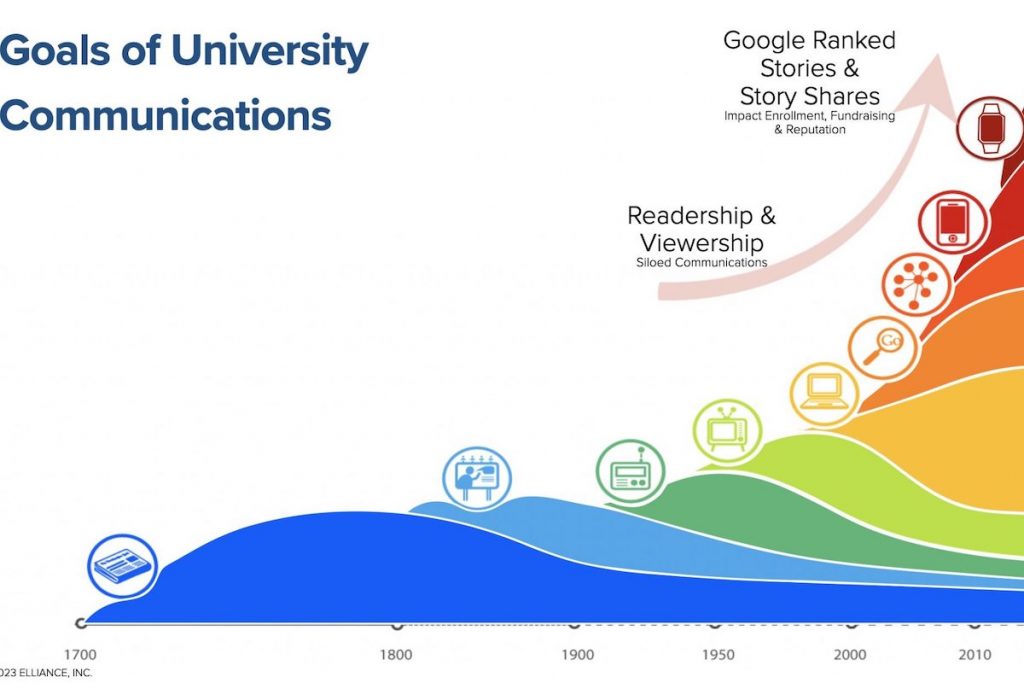| Sep 5, 2023
Productive content: how to shift from a promotion mindset to a publishing mindset.

When I left journalism and joined Elliance in the Fall of 2006, Facebook had recently celebrated its second birthday, Google had just paid $1.65 billion for YouTube, and some of America’s old-growth daily newspapers had begun to sway violently against the winds of economic change.
The new laws of digital communication had emerged, along with a breathtaking set of opportunities. But when I spoke to higher education communications leaders, I found that many still gauged success (personal and professional) by the number of returned phone calls and media placements they secured from local education beat writers or broadcast media.
Within weeks of crossing over to the digital side, I realized that colleges and universities possessed far more control over their reputation destinies than any of them seemed to grasp. My old-school eyes had opened wide to new tools of the trade:
- I learned to combine the power of keywords and code to win page one Google results for a range of content.
- I saw that stories could be curated with an eye toward building a critical mass of related keyword phrases and that these clusters could in turn become foundational to a school’s long-range enrollment, reputation, and fund-raising aspirations.
- I understood that college presidents, faculty, researchers, and alumni could all become characters in a larger institutional story and content strategy.
Seventeen years later, very few higher education vice presidents for communication — or their peers in enrollment, marketing, and advancement — have fully seized this opportunity. Most remain in a promotion rather than a publishing mindset. And while they work tirelessly to produce content, few understand the steps to make it “productive.”
More specifically:
- Most colleges and universities squander the potential impact and reach of their flagship publications, posting them as PDFs and embeddable flipbooks that put the valuable content beyond reach of Google’s indexing bots.
- Most colleges and universities operate without an extensive keyword guide.
- Most colleges and universities fail to connect communication efforts with broader strategic enrollment, reputation, and advancement goals.
Like Vladimir and Estragon from Samuel Beckett’s Waiting for Godot, higher education leaders appear trapped by inertia, hopeful that sheer effort and faith will be enough.
The good news is that anyone can claim their destiny with a few simple steps:
- Set aside any turf battles or territorial claims and convene your counterparts in enrollment, advancement, marketing/communications, and the president’s office and make a pact — to better understand how content productivity can change the institution’s destiny.
- Ask each representative to make a list of five non-branded keyword phrases that would be of strategic value (non-branded meaning phrases that do not use any iteration of your name or derivatives of your name).
- Begin an inventory of all existing/archived content, and it’s potential for digital productivity.
Just as the curtain eventually falls on Beckett’s Vladimir and Estragon, some colleges have gone out of business over these past 17 years — unaware until the last day of their potential to change their fate.
Todd will co-present a webinar titled Web Smart Writing on Wednesday, September 20 at 1 PM (EST) with Moderator Kat Liendgens, CEO of Hannon Hill. Registration information here: https://hannonhill.zoom.us/webinar/register/6816923245312/WN_oDNvP0PUQcKOMHNNYUjp-g#/registration
